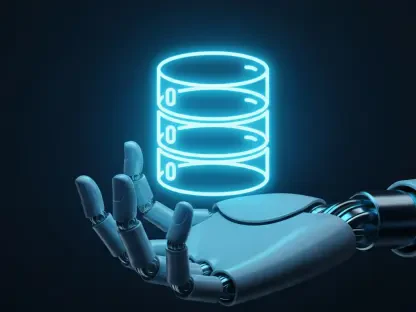The technological landscape has been transformed by the integration of artificial intelligence (AI) in software development processes, particularly through large language models (LLMs) that generate code at an unprecedented scale. While these advancements seem to herald an era of efficient and rapid software creation, challenges in making AI-generated code production-ready persist. In 2025, machines produced 41% of all code, amounting to a staggering 256 billion lines. Notably, even a tech giant like Google has embraced AI to draft around 25% of its code. On the surface, this might suggest a revolution in software development, yet the complex reality involves significant hurdles. The task of compiling, testing, and polishing this machine-generated code is crucial for ensuring it operates seamlessly in production environments. Unlike the commonly held perception of AI-generated code being inherently flawless, real-world experiences reveal that it often introduces unique bugs and security vulnerabilities, necessitating human oversight and intervention.
Surge in AI-Generated Code
Developers increasingly rely on AI to expedite the coding process, driving a massive increase in the volume of machine-generated code. This reliance reflects a broader industry trend aiming to leverage AI’s capabilities for efficiency and innovation. The numbers are eye-catching: AI now contributes nearly half of all new code. Such statistics highlight the promise of AI in revolutionizing coding by handling enormous workloads swiftly and with apparent ease. Yet, beneath this façade of progress lies a fundamental challenge. The speed at which AI generates code does not inherently translate into readiness for deployment. Instead, developers must contend with the additional complexity of ensuring this code adheres to necessary quality and security standards. The disconnect between rapid code generation and the slow, meticulous process of preparing it for production is a key issue that development teams face. This phenomenon underscores the critical importance of human oversight in bridging the gap between AI’s capabilities and the demands of real-world software applications.
AI’s ability to draft code quickly shifts the focus from pure generation to the nuanced tasks of refinement and validation. Machine-generated code often exhibits patterns of errors stemming from inaccurate library usage, overlooked logic errors, and violations of build constraints. It is crucial for developers to address these challenges, ensuring the code is not only functionally correct but also robust and secure. In this context, AI’s role becomes paradoxical; while it aids in initial coding, it concurrently demands human expertise to rectify and enhance the machine’s output. This evolving dynamic challenges developers to adapt their roles, transitioning from mere code writers to astute overseers who guide and improve AI-generated content. The industry is recognizing that while AI can automate the routine aspects of coding, it mandates human vigilance to verify and refine its work, solidifying the integral role of skilled professionals in tech development.
The Role of Human Expertise
In the evolving landscape of AI-driven software development, human expertise remains essential for transforming AI-generated code from a draft to a production-ready product. As coding becomes increasingly automated, the value of human intervention, particularly in quality assurance and debugging, continues to grow. Empirical evidence supports this necessity: a recent survey of engineering leaders revealed that AI-generated code frequently contains subtle bugs and security issues, with 59% of respondents acknowledging that such code introduced errors at least half the time. Moreover, 67% of these leaders noted an increase in the time spent debugging AI-written code compared to their own, while 68% invested extra effort in mitigating security vulnerabilities introduced by AI.
This data highlights a critical need for human oversight in the software development lifecycle, emphasizing the indispensable role that skilled developers play in the refinement and deployment of machine-generated code. Far from eliminating the need for human input, AI amplifies it, shifting responsibilities from code generation to more complex tasks like debugging and security assessment. Developers are now tasked with ensuring that AI-written code integrates seamlessly with existing systems, maintaining functionality and avoiding disruptions. This evolving role transforms developers into supervisors and mentors, who not only correct errors but also provide a quality check that machines cannot yet replicate. This ongoing necessity for human insight underscores the limitations of relying solely on AI for end-to-end software development, reinforcing the idea that humans are irreplaceable in achieving production-readiness.
Moreover, AI’s limitations in understanding context, intuition, and the broader implications of coding decisions further necessitate human involvement at critical stages of development. While AI excels at pattern recognition and data analysis, it lacks the nuanced understanding of project-specific requirements and the ethical considerations inherent in software design. Humans bridge this gap by evaluating AI’s output against a backdrop of experience, intuition, and contextual awareness. This synthesis of machine efficiency and human expertise is where the most significant advances in software quality and reliability occur. Human oversight ensures that AI-generated code meets the stringent standards required for efficient and secure operation in diverse production environments, ultimately safeguarding users and systems from potential vulnerabilities.
Utilization of AI Tools for Quality Assurance
As companies and developers navigate the intricacies of AI-generated code, specialized tools emerge to assist in quality assurance and validation, augmenting human intervention. Organizations recognize the potential of using AI to address its own shortcomings, leading to the development of tools specifically designed to identify and rectify common issues in machine-generated code. These tools, such as SonarQube and Snyk, integrate AI-enhanced quality scanning capabilities to detect and address coding and security issues before the code is merged into projects. This proactive approach is crucial for catching bugs early in the development process, thereby preventing longer-term issues and enhancing the overall reliability of software systems.
Additionally, automated test generation has become a pivotal component in the software development toolkit. Tools like Diffblue Cover leverage AI to create extensive unit tests for Java code, expediting the testing phase and significantly reducing bottlenecks encountered by human developers. Such tools allow for speedier development cycles without compromising on code quality. By automating test creation, developers can focus on the more intricate aspects of software refinement and enhancement. Tools like NativeLink further optimize the development process by streamlining build processes, reducing build times dramatically, and facilitating a more efficient workflow. This array of tools demonstrates the potential of AI to not only generate code but also enhance quality assurance measures, providing robust support to the human developers who oversee these processes.
Furthermore, AI-assisted code reviews are gaining traction, with platforms such as GitHub Copilot introducing automated pull request reviews. These tools offer a preliminary check for potential bugs and security flaws, providing a valuable first layer of scrutiny before human reviewers engage with the code. By flagging issues early, these solutions help human developers focus on more nuanced inspection tasks, ultimately refining the final output. Projects like Zencoder illustrate the potential of collaborative multi-agent AI pipelines, where specialized bots work together to produce, test, and refine code, enhancing the likelihood of achieving a production-ready state from the outset. This innovative approach aligns machine efficiencies with human oversight, setting a foundation for future developments in AI-assisted coding processes.
Best Practices for Integrating AI in Development
Amid the increasing reliance on AI-generated code, development teams are adopting best practices to effectively integrate AI into the software creation process. A strategic approach begins with treating AI output as a preliminary draft, emphasizing the importance of rigorous review and refinement. Senior engineers should critically evaluate AI-generated code, ensuring it meets established quality and security benchmarks before deployment. This practice mirrors the review processes applied to junior developers’ work, underscoring the necessity of human judgment in assessing machine output. Cultivating a culture of skepticism and scrutiny within development teams can help mitigate the risks associated with blindly trusting AI-generated code. Mandating comprehensive reviews by experienced engineers is essential for identifying and addressing potential deficiencies, ensuring the code’s robustness and reliability.
Integrating robust quality checks into the development pipeline is another essential strategy. Continuous integration and delivery (CI/CD) systems must include foundational checks such as static analysis, linting, and security scanning to identify vulnerabilities early in the development process. Tools like Jenkins, GitHub Actions, and GitLab CI offer the capacity to run suites like SonarQube, ESLint, Bandit, or Snyk on each commit, thereby automating the detection of coding and security issues. This proactive stance enables teams to rectify potential problems before they become entrenched, streamlining the overall workflow and enhancing code quality. Ensuring all code undergoes these rigorous assessments, especially AI-generated segments, reinforces a commitment to uphold high-quality standards.
Additionally, development teams can leverage AI for more than just coding; AI can be instrumental in testing workflows as well. By using AI to generate unit tests or test data, teams can expedite the validation process, compelling AI-generated code to withstand rigorous examination. GitHub Copilot, for instance, can assist in drafting unit tests for specific functions, while specialized tools like Diffblue Cover bulk-generate tests for existing codebases. This approach saves time and enforces a practice of validating AI-generated code against predefined test cases. Encouraging this verification mindset instills confidence in the code’s functionality and security, reinforcing the principle of “trust but verify” in software development.
Looking Forward: The Future of AI and Human Collaboration
Artificial intelligence (AI) has significantly reshaped the technological landscape, especially through its integration in software development. Large language models (LLMs) play a crucial role by generating code on a remarkable scale, hinting at a new era of efficient and swift software creation. As of 2025, machines have generated 41% of all code, amounting to an impressive 256 billion lines. Even a tech powerhouse like Google has adopted AI to draft about 25% of its code. Although these numbers may suggest a revolutionary shift in software development, the reality is far more complex and presents substantial challenges. The crucial tasks of compiling, testing, and refining AI-generated code are essential to ensure its seamless operation in production environments. Contrary to the belief that AI-generated code is inherently error-free, practical experiences highlight that it often introduces unique bugs and security vulnerabilities. This necessitates human oversight and intervention to address these issues effectively, ensuring reliability and security.









